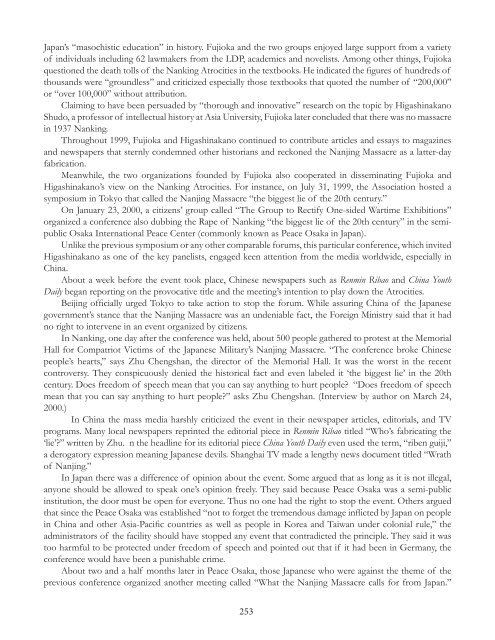Download - Canada ALPHA
Download - Canada ALPHA
Download - Canada ALPHA
Create successful ePaper yourself
Turn your PDF publications into a flip-book with our unique Google optimized e-Paper software.
Japan’s “masochistic education” in history. Fujioka and the two groups enjoyed large support from a variety<br />
of individuals including 62 lawmakers from the LDP, academics and novelists. Among other things, Fujioka<br />
questioned the death tolls of the Nanking Atrocities in the textbooks. He indicated the fi gures of hundreds of<br />
thousands were “groundless” and criticized especially those textbooks that quoted the number of “200,000”<br />
or “over 100,000” without attribution.<br />
Claiming to have been persuaded by “thorough and innovative” research on the topic by Higashinakano<br />
Shudo, a professor of intellectual history at Asia University, Fujioka later concluded that there was no massacre<br />
in 1937 Nanking.<br />
Throughout 1999, Fujioka and Higashinakano continued to contribute articles and essays to magazines<br />
and newspapers that sternly condemned other historians and reckoned the Nanjing Massacre as a latter-day<br />
fabrication.<br />
Meanwhile, the two organizations founded by Fujioka also cooperated in disseminating Fujioka and<br />
Higashinakano’s view on the Nanking Atrocities. For instance, on July 31, 1999, the Association hosted a<br />
symposium in Tokyo that called the Nanjing Massacre “the biggest lie of the 20th century.”<br />
On January 23, 2000, a citizens’ group called “The Group to Rectify One-sided Wartime Exhibitions”<br />
organized a conference also dubbing the Rape of Nanking “the biggest lie of the 20th century” in the semipublic<br />
Osaka International Peace Center (commonly known as Peace Osaka in Japan).<br />
Unlike the previous symposium or any other comparable forums, this particular conference, which invited<br />
Higashinakano as one of the key panelists, engaged keen attention from the media worldwide, especially in<br />
China.<br />
About a week before the event took place, Chinese newspapers such as Renmin Ribao and China Youth<br />
Daily began reporting on the provocative title and the meeting’s intention to play down the Atrocities.<br />
Beijing offi cially urged Tokyo to take action to stop the forum. While assuring China of the Japanese<br />
government’s stance that the Nanjing Massacre was an undeniable fact, the Foreign Ministry said that it had<br />
no right to intervene in an event organized by citizens.<br />
In Nanking, one day after the conference was held, about 500 people gathered to protest at the Memorial<br />
Hall for Compatriot Victims of the Japanese Military’s Nanjing Massacre. “The conference broke Chinese<br />
people’s hearts,” says Zhu Chengshan, the director of the Memorial Hall. It was the worst in the recent<br />
controversy. They conspicuously denied the historical fact and even labeled it ‘the biggest lie’ in the 20th<br />
century. Does freedom of speech mean that you can say anything to hurt people? “Does freedom of speech<br />
mean that you can say anything to hurt people?” asks Zhu Chengshan. (Interview by author on March 24,<br />
2000.)<br />
In China the mass media harshly criticized the event in their newspaper articles, editorials, and TV<br />
programs. Many local newspapers reprinted the editorial piece in Renmin Ribao titled “Who’s fabricating the<br />
‘lie’?” written by Zhu. n the headline for its editorial piece China Youth Daily even used the term, “riben guiji,”<br />
a derogatory expression meaning Japanese devils. Shanghai TV made a lengthy news document titled “Wrath<br />
of Nanjing.”<br />
In Japan there was a difference of opinion about the event. Some argued that as long as it is not illegal,<br />
anyone should be allowed to speak one’s opinion freely. They said because Peace Osaka was a semi-public<br />
institution, the door must be open for everyone. Thus no one had the right to stop the event. Others argued<br />
that since the Peace Osaka was established “not to forget the tremendous damage infl icted by Japan on people<br />
in China and other Asia-Pacifi c countries as well as people in Korea and Taiwan under colonial rule,” the<br />
administrators of the facility should have stopped any event that contradicted the principle. They said it was<br />
too harmful to be protected under freedom of speech and pointed out that if it had been in Germany, the<br />
conference would have been a punishable crime.<br />
About two and a half months later in Peace Osaka, those Japanese who were against the theme of the<br />
previous conference organized another meeting called “What the Nanjing Massacre calls for from Japan.”<br />
253


